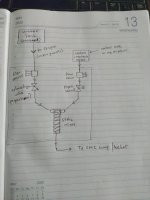Hello,
I am trying to make an Automatic Coolant Dispensing station for my client. This unit will be stationed next to a CNC Machine to monitor the coolant in the sump.
I have drawn a schematic of the unit. Feel free to suggest changes or improvements if any.
Quick description of requirement :-
- There are two flow streams entering the dispenser : one of water and one of coolant concentrate. Both are introduced under gravity. The water will be fed through the plant's overhead tank through a pipe, while the coolant concentrate will arrive through a 100Ltr tank in my unit.
- I am going to install flow sensors in both lines followed by Solenoid Valves in each line.
- Both lines shall then be fed into a Static mixer to carry out the mixing.
- The flow-rate of water varies. How do I control flow-rate of coolant to match that of water? For eg. If I am going for a 1% concentration of mixture for a 100 Litre total addition which makes it 1 Litre of concentrate mixed with 99 Litres of water, can I use a PLC to proportionately control the opening & closing of both the valves as per the input from the Flow sensors?
These are the flow-sensors I am going to use - https://broiltech.com/plastic-helical-rotor-flow-sensor-and-meter/45
I have sourced PWM Valves and a Controller from Asco (Emerson), but they are out of my budget. Any other way I can approach this application?
Guidance will be appreciated

I am trying to make an Automatic Coolant Dispensing station for my client. This unit will be stationed next to a CNC Machine to monitor the coolant in the sump.
I have drawn a schematic of the unit. Feel free to suggest changes or improvements if any.
Quick description of requirement :-
- There are two flow streams entering the dispenser : one of water and one of coolant concentrate. Both are introduced under gravity. The water will be fed through the plant's overhead tank through a pipe, while the coolant concentrate will arrive through a 100Ltr tank in my unit.
- I am going to install flow sensors in both lines followed by Solenoid Valves in each line.
- Both lines shall then be fed into a Static mixer to carry out the mixing.
- The flow-rate of water varies. How do I control flow-rate of coolant to match that of water? For eg. If I am going for a 1% concentration of mixture for a 100 Litre total addition which makes it 1 Litre of concentrate mixed with 99 Litres of water, can I use a PLC to proportionately control the opening & closing of both the valves as per the input from the Flow sensors?
These are the flow-sensors I am going to use - https://broiltech.com/plastic-helical-rotor-flow-sensor-and-meter/45
I have sourced PWM Valves and a Controller from Asco (Emerson), but they are out of my budget. Any other way I can approach this application?
Guidance will be appreciated

Last edited:





